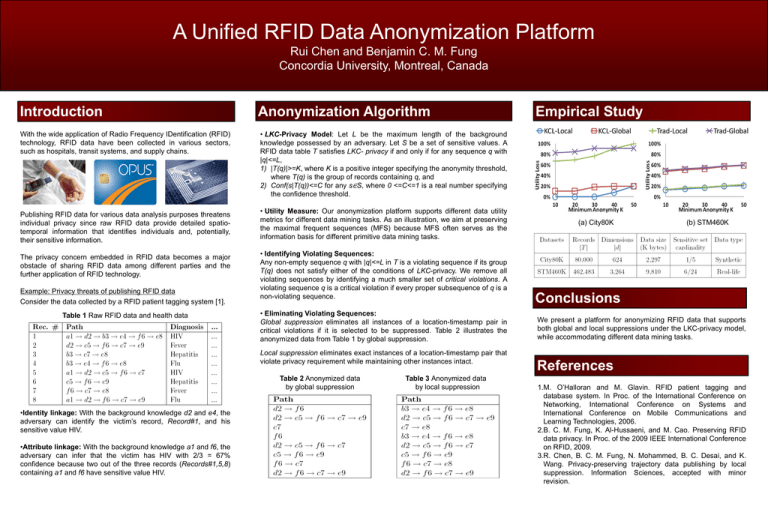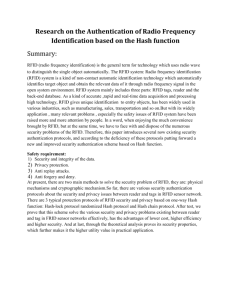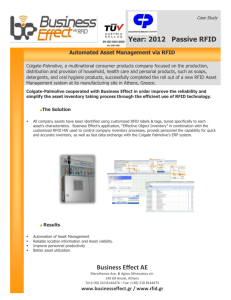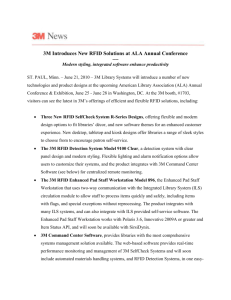Research Poster 24 x 36 - J - Data Mining and Security Lab @ McGill
advertisement

A Unified RFID Data Anonymization Platform Rui Chen and Benjamin C. M. Fung Concordia University, Montreal, Canada Introduction With the wide application of Radio Frequency IDentification (RFID) technology, RFID data have been collected in various sectors, such as hospitals, transit systems, and supply chains. Publishing RFID data for various data analysis purposes threatens individual privacy since raw RFID data provide detailed spatiotemporal information that identifies individuals and, potentially, their sensitive information. The privacy concern embedded in RFID data becomes a major obstacle of sharing RFID data among different parties and the further application of RFID technology. Example: Privacy threats of publishing RFID data Consider the data collected by a RFID patient tagging system [1]. Table 1 Raw RFID data and health data Anonymization Algorithm • LKC-Privacy Model: Let L be the maximum length of the background knowledge possessed by an adversary. Let S be a set of sensitive values. A RFID data table T satisfies LKC- privacy if and only if for any sequence q with |q|<=L, 1) |T(q)|>=K, where K is a positive integer specifying the anonymity threshold, where T(q) is the group of records containing q, and 2) Conf(s|T(q))<=C for any s∈S, where 0 <=C<=1 is a real number specifying the confidence threshold. • Utility Measure: Our anonymization platform supports different data utility metrics for different data mining tasks. As an illustration, we aim at preserving the maximal frequent sequences (MFS) because MFS often serves as the information basis for different primitive data mining tasks. • Identifying Violating Sequences: Any non-empty sequence q with |q|<=L in T is a violating sequence if its group T(q) does not satisfy either of the conditions of LKC-privacy. We remove all violating sequences by identifying a much smaller set of critical violations. A violating sequence q is a critical violation if every proper subsequence of q is a non-violating sequence. • Eliminating Violating Sequences: Global suppression eliminates all instances of a location-timestamp pair in critical violations if it is selected to be suppressed. Table 2 illustrates the anonymized data from Table 1 by global suppression. Local suppression eliminates exact instances of a location-timestamp pair that violate privacy requirement while maintaining other instances intact. Table 2 Anonymized data by global suppression •Identity linkage: With the background knowledge d2 and e4, the adversary can identify the victim’s record, Record#1, and his sensitive value HIV. •Attribute linkage: With the background knowledge a1 and f6, the adversary can infer that the victim has HIV with 2/3 = 67% confidence because two out of the three records (Records#1,5,8) containing a1 and f6 have sensitive value HIV. Empirical Study Table 3 Anonymized data by local suppression (a) City80K (b) STM460K Conclusions We present a platform for anonymizing RFID data that supports both global and local suppressions under the LKC-privacy model, while accommodating different data mining tasks. References 1.M. O’Halloran and M. Glavin. RFID patient tagging and database system. In Proc. of the International Conference on Networking, International Conference on Systems and International Conference on Mobile Communications and Learning Technologies, 2006. 2.B. C. M. Fung, K. Al-Hussaeni, and M. Cao. Preserving RFID data privacy. In Proc. of the 2009 IEEE International Conference on RFID, 2009. 3.R. Chen, B. C. M. Fung, N. Mohammed, B. C. Desai, and K. Wang. Privacy-preserving trajectory data publishing by local suppression. Information Sciences, accepted with minor revision.






